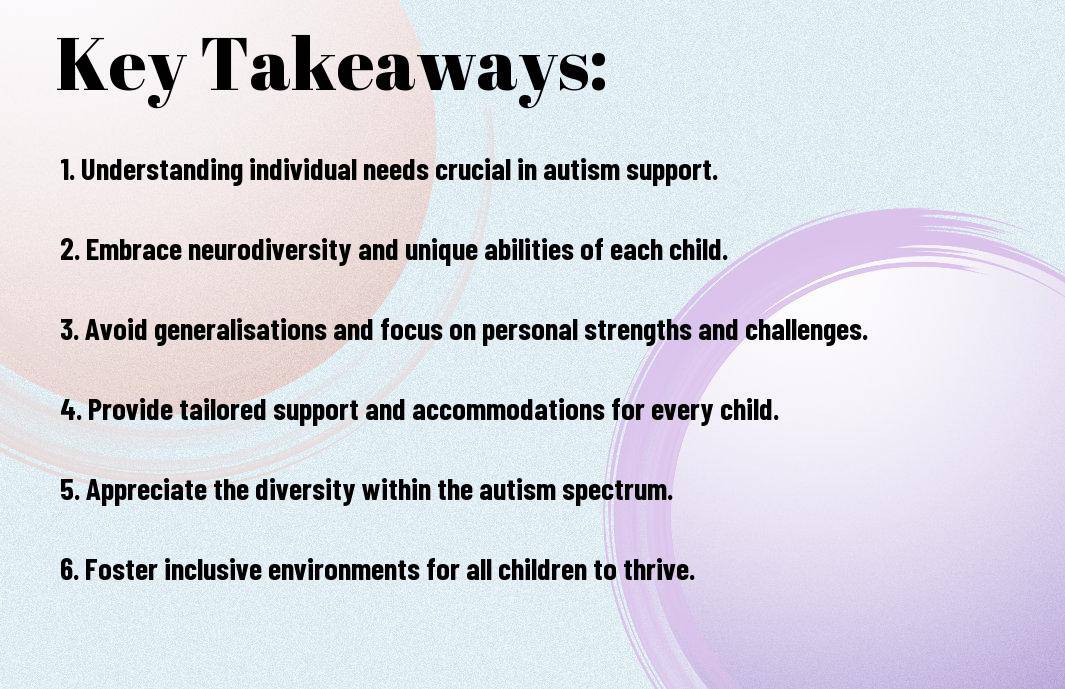It is an indisputable fact that autism is often misunderstood and misrepresented in society. The stereotypes and misconceptions surrounding this complex neurodevelopmental disorder can have significant implications for individuals and their families. In this blog post, we will delve into the unique profiles of children with autism, highlighting the importance of recognising and celebrating their individuality. Understanding the diversity within the autism spectrum is crucial for providing appropriate support and Parenting behavior and the development of children with autism. By shedding light on the positive attributes and challenges that come with each child’s unique profile, we hope to foster greater awareness and acceptance of autism in our society.
Key Takeaways:
- Individuality: Each child with autism has a unique profile, with their own strengths, challenges, and preferences.
- Challenging Stereotypes: It’s important to move beyond the stereotypes and recognise the individuality of each child with autism.
- Personalised Support: By understanding each child’s unique profile, we can provide personalised support and interventions that best suit their needs.


Unpacking the Stereotypes
When it comes to autism, there are numerous stereotypes that have prevailed over the years. It’s essential to unpack these stereotypes to gain a deeper understanding of each child’s unique profile.
| Myth: Autism is a mental illness | Fact: Autism is a neurodevelopmental disorder |
| Myth: Autistic individuals lack empathy | Fact: Autistic individuals may experience empathy differently |
| Myth: Autism is caused by bad parenting | Fact: Autism is a complex combination of genetic and environmental factors |
| Myth: All autistic individuals are nonverbal | Fact: Many autistic individuals are verbal |
| Myth: Autism can be cured | Fact: There is no known cure for autism |
Common Misconceptions About Autism
One common misconception about autism is that all autistic individuals have extraordinary abilities in specific areas. While some individuals may possess exceptional skills, it is essential to understand that autism is a spectrum. Not all individuals will exhibit these remarkable talents. Another misconception is the belief that autistic individuals are intellectually impaired. In reality, autism does not correlate with intelligence. There is a wide range of cognitive abilities within the autistic community.
The Impact of Media on Autism Perception
The portrayal of autism in the media has a significant impact on how it is perceived by the public. Unfortunately, media representations often perpetuate stereotypical and inaccurate depictions of autism. These portrayals can lead to misperceptions and misunderstandings of individuals on the autism spectrum. It is crucial to challenge these misconceptions and advocate for authentic and nuanced representations of autism in the media.
Furthermore, sensationalized stories about autism can perpetuate stigma and hinder the acceptance and inclusion of autistic individuals in society. It is vital to critically analyse the media’s portrayal of autism and work towards accurate and respectful representations.
The Spectrum of Diversity
When it comes to autism, there is a wide spectrum of diversity that goes beyond the stereotypes. Each individual with autism has a unique profile and experiences the condition in their own way. Understanding this diversity is crucial in providing the right support and resources for individuals on the autism spectrum. To delve deeper into this topic, you can read our blog post on Is Everyone On The Autism Spectrum?
Biological and Neurological Variabilities
One of the key aspects of autism diversity lies in the biological and neurological variabilities among individuals. While some may have certain genetic traits or brain differences, others may not exhibit these characteristics. It’s important to recognise that there is not a one-size-fits-all explanation for the biological and neurological aspects of autism.
Understanding these variabilities is crucial in recognising the unique needs and challenges that individuals on the autism spectrum may face. By acknowledging and embracing these differences, we can work towards creating a more inclusive and supportive environment for everyone.
Personality, Interests, and Ability Differences
Personality, interests, and ability differences further add to the diversity within the autism spectrum. Each individual has their own unique set of strengths, interests, and abilities, and it’s important not to overlook these differences. Embracing the diversity within the autism spectrum means recognising the individuality and strengths that each person possesses.
By acknowledging and valuing these differences, we can create a more inclusive society that celebrates the positive contributions of individuals on the autism spectrum.
It’s important to note that these personality, interests, and ability differences are not limitations, but rather unique characteristics that contribute to the rich diversity of the autism spectrum. By embracing and understanding these differences, we can create a more positive and inclusive environment for all individuals.

Tailoring Support and Advocacy
When it comes to supporting individuals with autism, one size definitely does not fit all. Each child with autism has their own unique strengths, challenges, and needs. This is why it is crucial to tailor support and advocacy to the individual, taking into account their specific profile and requirements.
Importance of Individualized Support Plans
Individualized support plans are essential for individuals with autism as they ensure that the specific needs of the individual are addressed in a personalised manner. These plans take into consideration the individual’s strengths, challenges, sensory sensitivities, communication preferences, and behavioural patterns. By tailoring support in this way, individuals with autism can receive highly targeted assistance that is tailored to their unique profile, maximising their potential for growth and development.
Family, School, and Community Roles in Empowerment
Empowerment of individuals with autism involves a collaborative effort from their family, school, and community. Support from family members, educators, and community organisations is crucial in creating a holistic support system that nurtures the strengths and abilities of individuals with autism. By working together, these stakeholders can provide a supportive and inclusive environment that fosters empowerment and self-determination for individuals with autism.
In addition to receiving professional support, families, schools, and the wider community can play a significant role in the success of individuals with autism through understanding, acceptance, and provision of opportunities that foster growth and independence.
Stories from the Spectrum
Every child on the autism spectrum has a unique journey, and their stories deserve to be heard. In this chapter, we will delve into the diverse experiences of individuals on the autism spectrum, highlighting their strengths, challenges, and the impact on their families.
Case Studies: Profiles of Unique Journeys
Case studies offer valuable insights into the diverse profiles of individuals on the autism spectrum. Each case study provides a glimpse into the unique challenges and successes experienced by individuals with autism. Here are some detailed profiles of unique journeys:
- Case Study 1: A 10-year-old boy with autism spectrum disorder, non-verbal, excels in mathematics with an exceptional memory.
- Case Study 2: A 16-year-old girl with autism spectrum disorder, highly creative and artistic, struggles with sensory sensitivities.
- Case Study 3: A 12-year-old boy with autism spectrum disorder, passionate about music and technology, faces challenges in social interactions.
Celebrating Successes and Addressing Challenges
Although individuals on the autism spectrum may face challenges in various aspects of life, it’s essential to celebrate their successes. Alongside celebrating their achievements, it’s crucial to address the unique challenges they encounter in education, employment, and social interactions.
By highlighting the individual successes and addressing the challenges faced by individuals on the autism spectrum, we can promote a more inclusive and supportive environment for the diverse profiles within the autism community.
Conclusion: Beyond the Autism Stereotypes – Each Child’s Unique Profile
In conclusion, it is evident that the portrayal of autism in mainstream media and society often falls into stereotypes, limiting our understanding of the unique profiles of each child with autism. By recognising and respecting the individual differences and strengths of children with autism, we can better support their development and provide tailored interventions. It is crucial for us to move beyond the narrow stereotypes and embrace the diverse spectrum of autistic experiences. Only then can we create an inclusive and supportive environment that allows every child with autism to thrive and reach their full potential.
FAQ
Q: What is ‘Beyond the Autism Stereotypes – Each Child’s Unique Profile’ about?
A: ‘Beyond the Autism Stereotypes – Each Child’s Unique Profile’ is a comprehensive guide that explores the unique characteristics and traits of each child with autism, moving beyond common stereotypes and misconceptions.
Q: Why is it important to understand each child’s unique profile?
A: Understanding each child’s unique profile is crucial for providing effective support and intervention tailored to their specific needs, strengths, and challenges.
Q: How can ‘Beyond the Autism Stereotypes’ benefit parents and caregivers?
A: This resource can provide parents and caregivers with a deeper understanding of their child’s individuality and help them navigate the complexities of autism with greater insight and empathy.
Q: What strategies are included for supporting children with autism?
A: The book offers a range of practical strategies and approaches for providing a supportive and inclusive environment for children with autism, taking into account their individual profiles.
Q: What misconceptions about autism does the book address?
A: ‘Beyond the Autism Stereotypes’ addresses common misconceptions about autism, such as assuming all individuals on the spectrum have the same traits and capabilities.
Q: Is this resource suitable for professionals working with children with autism?
A: Yes, the book is a valuable resource for professionals, offering insights into understanding and supporting each child’s unique profile in both educational and clinical settings.
Q: How can ‘Beyond the Autism Stereotypes’ contribute to promoting inclusivity and understanding of autism?
A: By highlighting the diversity of traits and characteristics among children with autism, the book promotes inclusivity and challenges stereotypical perceptions, fostering greater understanding and acceptance in society.







